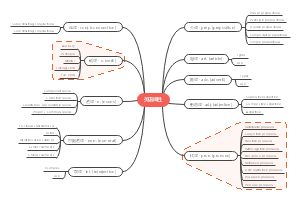导图社区 Morphology(形态学)
- 1.7k
- 21
- 4
- 举报
Morphology(形态学)
新编语言学教程第三章关于形态学的知识梳理。形态学是用来特指一门专门研究生物形式的本质的学科。这门形态学同那种把有机体的生物分解成各个单元的解剖学不同,不是只注重部分的微观分析而忽略了总体上的联系,相反它要求把生命形式当作有机的系统看待形态学的方法,一方面是对接受研究中的历史学方法的补充,另方面是对比较文学的文学性的继续关注。
编辑于2021-04-09 11:07:55- 形态学
- 刘润清 文旭
- 相似推荐
- 大纲
Morphology
Morphemes
Free morphemes e.g walk, friend
Root: it refers to a word must contain an element that can stand by itself, that is, a free morpheme, such as talk.
Stem: free morphemes are used with bound morphemes, the basic word-form involved is technically known as the stem. e. g. in works, work is both the root and the stem. in workers, work is the root, worker is the stem. in workshops, both work and shop are roots, workshop is the stem.
Lexical morphemes: all n. v. and a. which carry the content of massages we convey. (open class of words. ) e.g. book, look, happy
Functional morphemes: conj. art. prep. and pron. which are the functional words. (close class of words. )
Bound morpphemes e.g -ism, -er, im-
Affixes
root and stem
prefixes: 前缀 e.g. im-possable
suffixes: 后缀 e.g. kind-ness
infixes: 中缀 it is relatively rare in the languages of the world. e.g. Tagalog, a language spoken in the Philippines has the infix. su-mu-lat(wrote)
Derivational morphemes(派生语素): make new words and used to make words of a different grammatical category from the stem.
suffixes: -y, -ish, -ment, -ly preffixes: re-, pre-, dis-, co-, im-, un-
Inflectional morphemes(曲折语素)
singular or plural
past tense or present tense
possessive or comparative form(所有格,比较级)
Morpts and Allomorphd
Morphs are the smallest meaningful phonetic segments of an utterence on the level of parole. morphs are the phonological (spoken) or orthographic (written) forms which realize morphemes, and they are minimal carriers(媒介) of meaning.
morphemes in the abstract notion are symbolized by brace brackets{}
Allomorph is a member of a set of morphs which represent the same morphemes.
They are in complementary distribution(互补分配),they cannot occur in the same environment.
Types of Word Formation
The creation of new words is called word formation.
compounding: it refers to words which are formed by putting two words together. e.g. typewriter
n. compoundes 1. n. + n. : armchair 2. v. + n. : washcloth 3. a. + n. : highchair
v. compoundes 1. n. + v. : to vacuum-clean 2. v. + v. : to sleep-walk 3. a. + v. : to dry-clean
a. compoundes 1. n. + a. : color-blind 2. v. + a. : stir-crazy 3. a. + a. : dark-blue
derivation: it is done by adding affixes to other words or morphemes. e.g. childless
anti-: [against]. anti-terrorist -ation: v. → n. comput-ation -ful: [full of] and n. → a. color-ful -ment: v. → n. place-ment re-: [against or new] re-write -ware:it refers to products for running a computer, e.g.soft-ware cyber- and e-: [relating to tje internet] e.g. e-mail, cyberchat techno-: [relating to computer] e.g. technostress
conversion (zero derivation) : many words have more than one part of speech. e.g. bank(n./v.) He's papering the bedroom walls.
backformation: it refers to remove a suffix to get a new word. e.g. emotion→emote
clipping: abbreviations(缩写词) of longer words may become words. e.g. advertisement→ad
blending: a single new word can also be formed by combining two separate forms. e.g. breakfast+lunch→brunch
acronym: some new words are formed from the first letters of a series of words. e.g. TOEFL: Test of English as a Foreign Language.
initialism: some new words are composed of the first letters of a series of words and pronounced by saying each letter in them. e.g. VIP: very important person
a derivational word consists of at least a free morpheme and a bound morpheme
The first element in the compound receives the main stress, but it is generally the second element that determines the compound's new word class.
n. + -′s, -s (worker′s, workers) v. + -s, -ing, -ed, -en (works, working, worked) a. + -er, -est (later, laterest)
category









